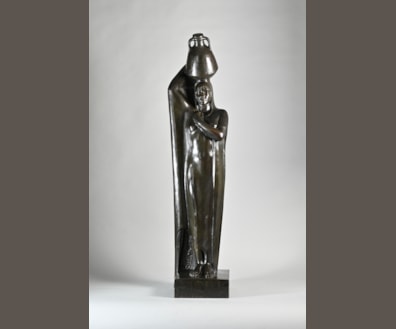
Charles Henri CORDIER
( 1827 - 1905 )
MAURESQUE D'ALGER CHANTANT
Possibly in pair with «Mauresque noire, buste grandeur nature»
Bronze, gilt and silvered patina.
H : 74 cm, L : 46 cm, D : 27 cm
Signed under the shoulder "Cordier"
Four examples currently identified including this one (3 bronzes reproduced in the catalogue raisonné, 6 marbles including the one at the Musée de l’Homme, and 7 half size bronze reductions).
Before 1870
Provenance : Former Claude Nicolas Edouard Tassard collection (1807-1888, judge closed to Baron Hausmann) then by descendance.
Buste grandeur nature (1856 ?)
Pendant de "Mauresque noire, buste grandeur nature"
Bronze à patine argentée et dorée.
Haut : 74 cm, Long : 46 cm, Prof : 27 cm
Signé sous l'épaule "Cordier".
Quatre épreuves identifiées avec celle-ci (3 bronzes dans le catalogue raisonné, 6 marbres incluant celui du musée de l'homme, et 7 réductions bronze à demi-grandeur)
Avant 1870
Provenance : ancienne collection du magistrat Claude Nicolas Edouard Tassard (1807-1888, proche du Baron Hausman) et par descendance.
literature
MARGERIE Laure, PAPET Edouard (dir.), Charles Cordier 1827-1905 l’autre et l’ailleurs, catalogue d'exposition (Paris, Musée d'Orsay; Quebec, Musée National des Beaux Arts du Quebec, 2004), Paris, Editions de la Martinière, 2004, pp. 189-190.
About Cordier and Polychromy in Sculpture :
BLUHM Andreas “In living colour. A short history of colour and sculpture in the 19th century” in BLUHM Andreas (dir.), The colour of sculpture 1840-1910, catalogue d’exposition (Amsterdam, Van Gogh museum; Leeds, Henry Moore Institute, 1996-1997), Zwolle, Waanders Uitgevers, 1996, pp. 36-39.
Detailed Description
First ethnographic sculptor in Art History, Charles Cordier focused on creating a serie of exotic portraits with a scientific and artistic spirit which were named "Types nègres", "Types Chinois", "Types arabes", "Type mauresque", "Type juive" by his contemporaries... The sculptor’s attention is drawn to the expressions and features of the face, but also to the details of the clothes after his first journey to North Africa in 1853. The sculptor became so important with this category of pieces that he created in 1862 his famous monumental Atlantes and Cariatides for the Rothschild at the Château de Ferrières.
He is one of the first artists who was interested in colors for sculpture, after 1855-1857 and used different materials for only one model: marble, bronze (usually mixing different patinas, golden or silvery, enhanced by enamels), onyx, etc. Craftman artist, he also attached importance to the quality of his production and especially in the finess of his bronzes. Subtlety of the chiselling, realistic and smart, which was led sometimes to an extreme point, like our bust where we can see the pigmenta-
tion of the skin and very fine details for the gaze.
The Mauresque d’Alger chantant was sometimes in pair with the Mauresque noire or Mulatresse , who wore a very similar costume. While Cordier was interested in the representation of the type, he also identified mixed-race faces: the Musée d’Orsay has a photograph of a marble example of this subject by Charles Marville, given by Cordier to the Ministry and annotated «Métis, singer, Turkish father, Moorish mother»; a similar photograph exists for the Mulatresse . The sculptor kept a marble example of the large size for his own Villa Mauresque in Orsay. Here, the vitality of the model is reinforced by the Hair and scarf softeness with the very fine detailed clothes which contribute to make our example a very lavish one. The richness is emphasized also by the usual double patina for this model in bronze, gilt and silvered.
This life-size example is signed in the mould below the shoulder "Cordier" and four examples are today identified with this one (3 bronzes in the catalogue raisonné, 6 marbles including the one in the Musée de l’Homme, and 7 half-size bronze reductions). It was originally part of the collection of Judge Claude Nicolas Edouard Tassard (1807- 1888, close to Baron Hausmann) and by descendance to this day.
You may also like












